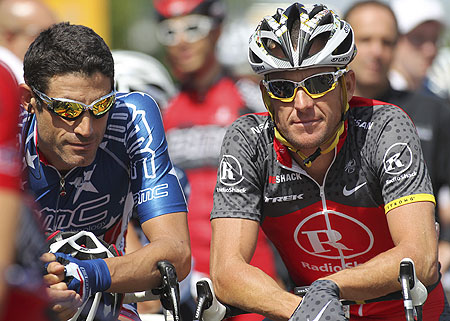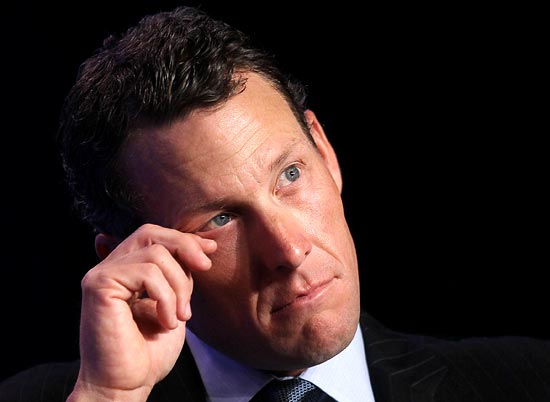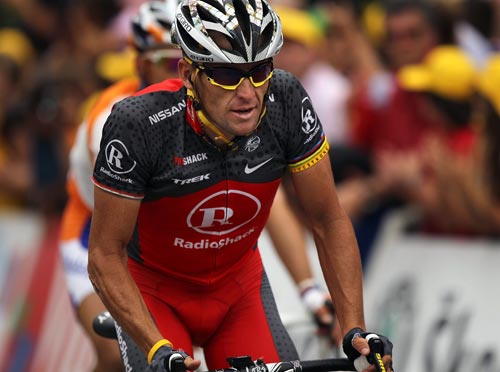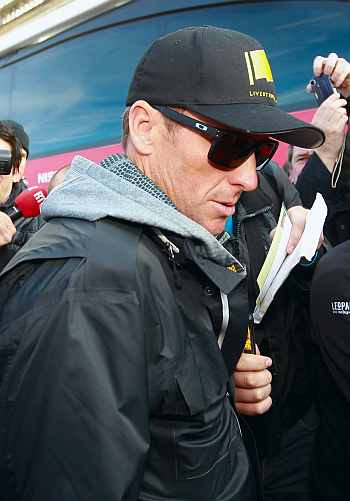Photographs: Eric Gaillard/Reuters
If the United States Anti-Doping Agency is right, then Lance Armstrong cheated his way to the top of the cycling world through an elaborate doping scheme never seen before in the sport.
- Former Armstrong teammate admits to doping
- Cyclist Lance Armstrong cheated: USADA report
- Read the complete USADA report (External link)
Hotel rooms were transformed into blood banks as riders were given late-night transfusions, doctors were paid off and competitors were warned about tests in advance, said the anti-doping agency, or USADA.
More than six weeks after it banned Armstrong for life and stripped him of his seven Tour de France titles, USADA revealed on Wednesday the findings of its investigation into Armstrong and his US Postal Service Pro Cycling Team.
Armstrong's lawyer called the investigation a "hatchet job" and "witch hunt." The champion cyclist has denied cheating and has never failed a doping test. But he did not fight the charges.
There were few new revelations in the 1,000-page report, but the weight of testimony was greater than any of the previous investigations into his conduct. (Report: http://www.usantidoping.org/)
His accusers said Armstrong -- one of the world's most famous athletes who also is well known for his cancer-fighting charity work -- was not only a willing participant, but the ringleaders, ordering teammates to cheat.
'I was obligated to tell the truth about everything I knew'
Image: Lance Armstrong (right) is pictured with former teammate George HincapiePhotographs: Anthony Bolante/Files/Reuters
In addition to financial payments, emails and laboratory test results that the agency says proves the use of performance enhancing drugs by Armstrong and the USPS Team, 26 people gave sworn testimony, including 11 former teammates.
Of the 11, the most surprising was George Hincapie, who rode alongside Armstrong when he won each of his Tour de France titles and was one of his most loyal and trusted friends.
"I would have been much more comfortable talking only about myself, but understood that I was obligated to tell the truth about everything I knew. So that is what I did," he said in a statement.
USADA's dossier was the most comprehensive report detailing his alleged transgressions and the agency said it had provided undeniable proof Armstrong was the center of a sophisticated doping program.
"His goal led him to depend on EPO, testosterone and blood transfusions but also, more ruthlessly, to expect and to require that his teammates would likewise use drugs to support his goals if not their own," the report said.
"The evidence is overwhelming that Lance Armstrong did not just use performance enhancing drugs, he supplied them to his teammates."
'USADA has continued its government-funded witch hunt'
Image: Lance ArmstrongPhotographs: Mario Tama/Getty Images
As expected, Armstrong's lawyers responded quickly and angrily, condemning the investigation as an inquisition based on unreliable accusations and sloppy procedures.
"USADA has continued its government-funded witch hunt of only Mr. Armstrong, a retired cyclist, in violation of its own rules and due process, in spite of USADA's lack of jurisdiction, in blatant violation of the statute of limitations," said Sean Breen, one of Armstrong's lawyers.
The International Cycling Union, or UCI, which has been highly critical of USADA's handling of the investigation, said it was considering what to do next as the fallout from the report began to unfold.
Five of Armstrong's former teammates, who were among the riders who testified against him, released separate statements admitting they had used performance drugs. Most of the others had already confessed to cheating.
The report included testimony that Armstrong and his team used a range of performance-enhancing drugs including erythropoietin (EPO), blood transfusions, testosterone, corticosteroids, human growth hormone and masking agents.
Armstrong was accused of encouraging other cyclists to use drugs
Image: Lance ArmstrongPhotographs: Bryn Lennon/Getty Images
The report covered Armstrong's professional career, including the seven years in a row when he won the Tour de France from 1999 to 2005, and provided graphic revelations about the methods it said he used to dope and avoid detection.
Floyd Landis, who was stripped of his 2006 Tour de France title for a positive doping test, and Tyler Hamilton, who was stripped of his 2004 Olympic gold medal after confessing to drug use, both previously pointed the finger at Armstrong.
On Wednesday, Christian van de Velde, Tom Danielson, David Zabreskie and Hincapie, who were identified among former Armstrong teammates who testified against him, also came clean and admitted cheating.
Armstrong was accused of trafficking and encouraging other cyclists to use drugs, as well as conspiring with team manager Johan Bruyneel, doctor Pedro Celaya, doctor Luis del Moral, doctor Michele Ferrari and trainer Jose Pepe Marti.
Ferrari and Del Moral were also given lifetime bans for their role in the alleged doping scheme while Bruyneel, Celaya and Marti are contesting the charges.
"From day one, we always hoped this investigation would bring to a close this troubling chapter in cycling's history and we hope the sport will use this tragedy to prevent it from ever happening again," USADA said.
'The team ran the most sophisticated, successful doping program'
Image: Lance ArmstrongPhotographs: Bryn Lennon/Getty Images
Although he has never failed a doping test, Armstrong has long been dogged by accusations he climbed to the top by using banned drugs.
The Texan has always denied any wrongdoing but was banned for life last month when he decided not to defend himself against USADA's doping charges.
He insisted his decision was not an admission of guilt and challenged USADA to prove its case. On Wednesday, the doping agency showed its hand by releasing a 200-page summary of the dossier it had sent to UCI, the World Anti-Doping Agency, or WADA, and the World Triathlon Corporation, or WTC.
"The evidence shows beyond any doubt that the US Postal Service Pro Cycling Team ran the most sophisticated, professionalised and successful doping program that sport has ever seen," USADA Chief Executive Travis Tygart said.
"The ... doping conspiracy was professionally designed to groom and pressure athletes to use dangerous drugs, to evade detection, to ensure its secrecy and ultimately gain an unfair competitive advantage through superior doping practices."
The UCI, which has the right to appeal USADA's rulings, said it was considering its position.
"The UCI will examine all information received in order to consider issues of appeal and recognition, jurisdiction and statute of limitation, within the term of appeal of 21 days, as required by the World Anti-Doping Code," the world governing body for cycling said.






Comment
article